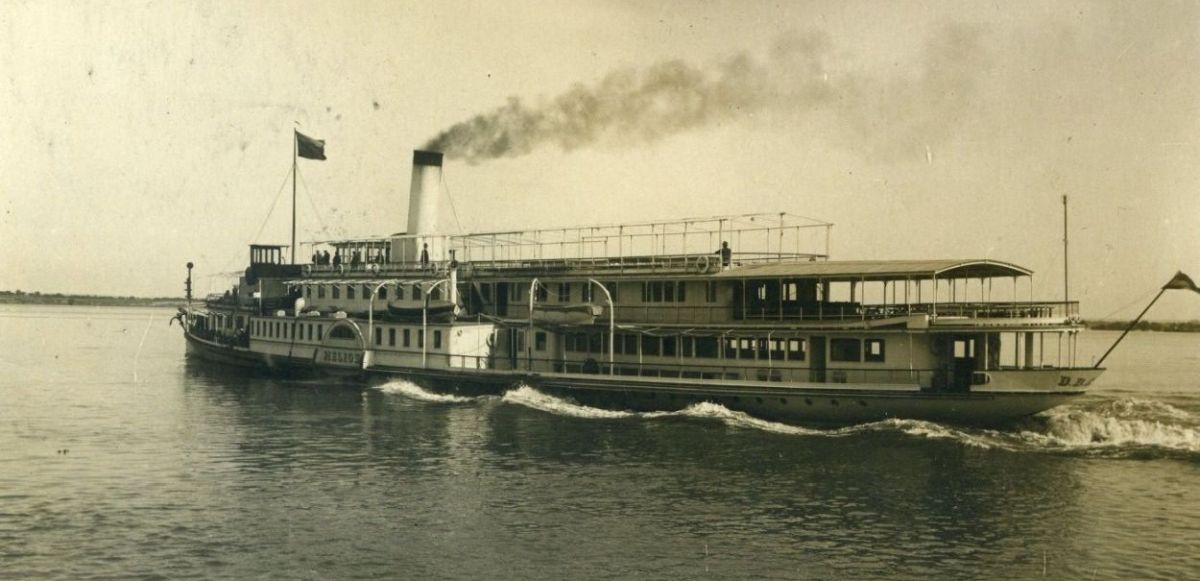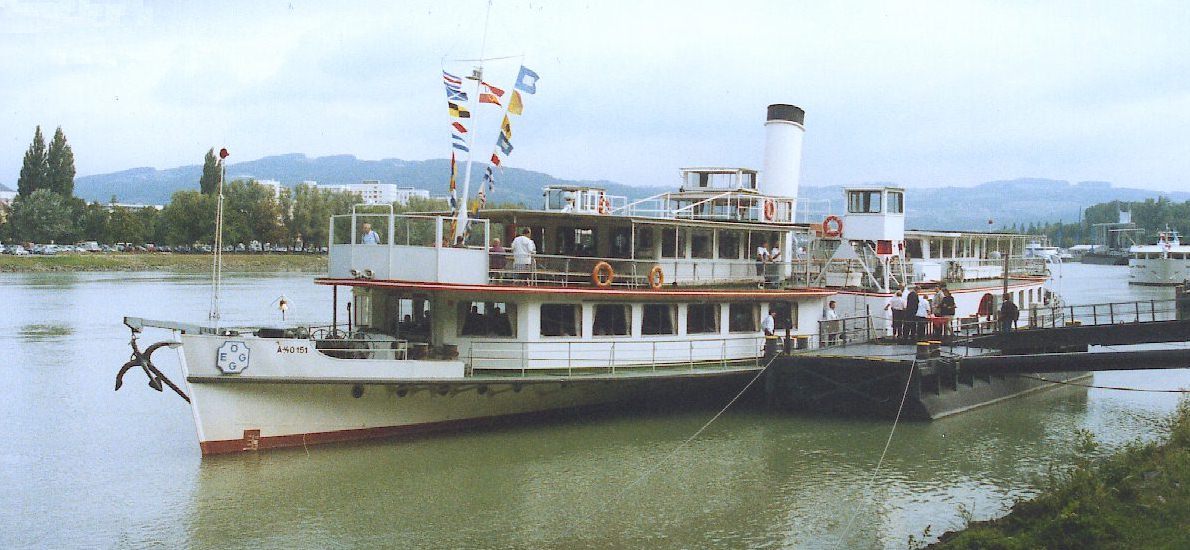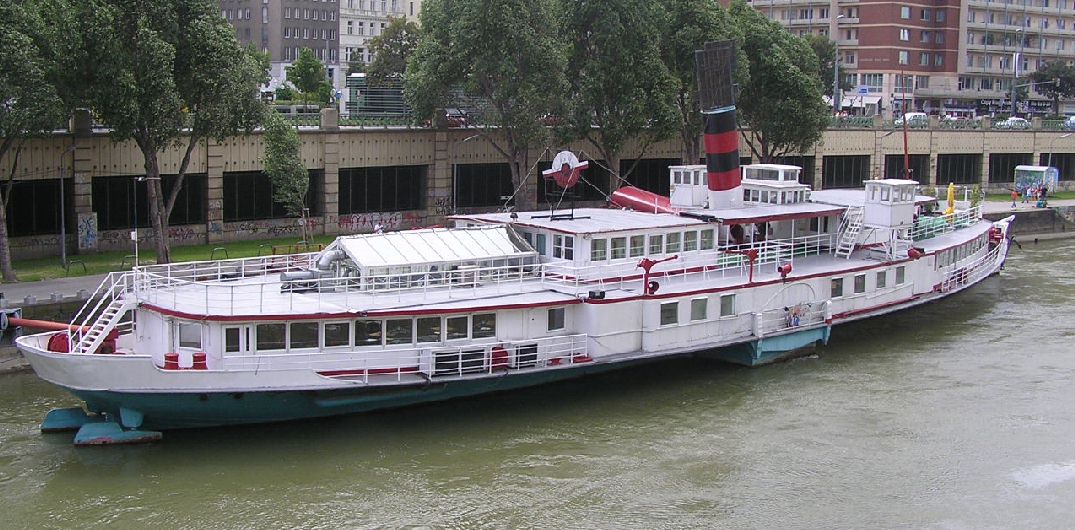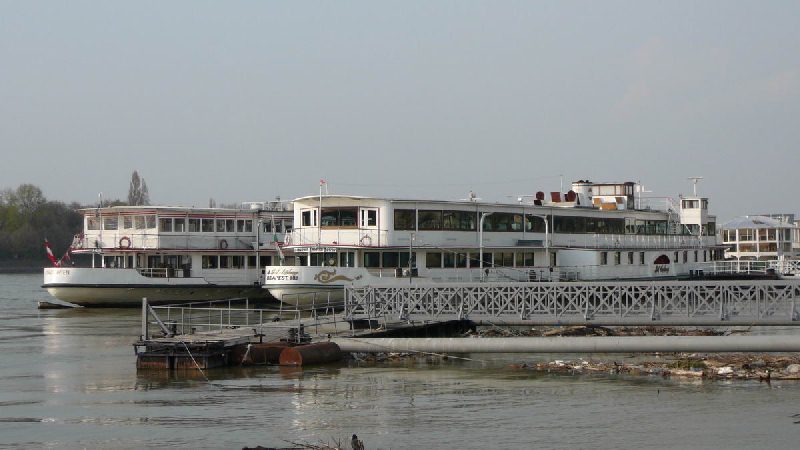paddlesteamers.info : The Internet's leading website for
Side-Wheeled Paddle Steamers
River Danube : Austria

Above : Express steamer Helios of 1922, the final paddle steamer built
for the DDSG and the ultimate design before diesel-electric paddlers Stadt
Wien and Stadt Passau of 1939/40.
Source : From a Bulgarian post card of the 1920s now in the public domain.
.
Paddle Steamer services on the Danube in
Austria are synonymous with the DDSG, which since its founding in
1830, dominated passenger and cargo traffic passing through the vast
territory of the Austro-Hungarian Empire. The increasing independence
of Hungary within the Empire lead to the formation of the MFTR , the
forerunner of today's MAHART, in 1896, providing effective
competition to the DDSG. Up until this time, DDSG had dominated the
river trade and in 1862 and 1874, absorbed the fleets of vanquished
German and Hungarian competitors.
After the end of the First World War, with it's political power base,
the Habsburg Empire, replaced by a number of independent states, much
of the fleet was lost to shipping companies established in the new
states. The Second World War was equally destructive, both in terms
of tonnage lost as a result of enemy action, and the subsequent loss
of all operations in other countries. The remaining assets of the
DDSG were placed under Soviet control, with the Soviet Union being
the Allied occupation force in eastern Austria, and nationalised in
1946. No new vessels were built until 1949, and passenger ships based
at Vienna were restricted to the Soviet occupation zone until the
first post war service to Linz took place in 1954, one year before
the final political settlement reuniting an independent Austrian
republic.
The company was formed by two Englishmen, John Andrews and Joseph
Pritchard and an English vessel, Franz I was reassembled near Vienna
to make the first trip to Budapest in 1830. The first 12 vessels in
the fleet were passenger steamers, but in 1838, Eros appeared from
the company's own Altofen yard at today's Budapest, the first of a
long line of barges and tugs owned by the DDSG. Paddle ships were
particularly suited to the shallow waters along the enormous length
of the river and continued to be built new up until the 1940s, even
after steam power had been superceded by diesel motors. The DDSG also
ran two ships of extremely shallow draught with two sets of paddles
on either side - an arrangement which was not repeated despite the
ships working quite successfully in operation in the lower reaches of
the river.
One unusual propulsion method used by a limited number of vessels in
the fleet was chain haulage. Chains were laid along certian stretches
of the riverbed and fitted to ships by being lifted and placed to run
along the length of the deck and through the motor cylinder. As the
motor turned, the chain was pulled through the cylinder and the barge
moved along the chain. The first such vessels were built in 1870. By
1900 all had either been scrapped or converted to conventional
propulsion methods.
Schonbrunn was the last steamer to be withdrawn by DDSG - in 1988,
three years after the closure of the last remaining "long distance"
service from Vienna to Passau. This left the two diesel paddlers,
Stadt Wien and Stadt Passau, relegated to more local trips, but the
through service was restored in 1991 with Stadt Passau and in 1992
with Stadt Wien also rostered. Further confidence in the route was
signalled when the former holiday cruise vessel Theodor Koerner
joined the two paddlers in 1993, but the service finally closed after
the 1995 season.
By this time, DDSG's passenger and cargo operations had been split
and the more lucrative cargo operations had been taken over by a
German company. The day-trip operation continues, but only as a
shadow of its former self. In the 2000 season, five motor vessels
served the DDSG-Blue Danube Schiffahrt GmbH, including the Wachau and
Prinz Eugen on Wachau Valley cruises. Paddlers Stadt Wien, Stadt Passau (as Grof Szechenyi) and
Schonbrunn have been preserved and now operate under independent
ownership on their home river, based at Tulln, Budapest and Linz respectively
Passenger Paddle Steamers
As listed in "Vom Raddampfer zum Schubverband",
the "official" history of the DDSG by Hans
Scherer
Franz I
Argo
Pannonia, later Belgrad
Zrinyi
Ferdinand I
Nador, later Neptun
Arpad
Maria Anna
Sophia, later Minerva
Ludwig, later Albrecht, then Diana
Hermine
Johann
Stadt Wien
Stadt Pest
Friedrich
Buda
Szechenyi, later Szegedin
Attila
Sophie, later Melk
Greifenstein, later Pozsony, then Esseg
Franz Carl
Maria Dorothea (1846-1939) , later Rudolph (1859), then Aggstein (1938)
Nador, later Gisela
Ferdinand I
Hunyad
Gyor
Franz Joseph, later Boreas
Debrecen
Austria
Radetzky
Germania, later Balkan
Prater
Ebersdorf
Franz Josef I, later Neptun, then Melk
Albrecht
Stefan Szechenyi
Hidegarde
Ferdinand Max
Carl Ludwig (1853-1950 : later Grein and then the hull used in
Johann Strauss in 1950, withdrawn in 1972 and scrapped in 2018)
Elisabeth
Josef Carl (1854-1944 : later Tulln)
Tachtalia
Islas
Drau
Mercur
Konig Maximilian
Konigin Marie
Konigin Therese
Regensburg
Donauworth
Konig Ludwig
Bavaria
Prinz Otto
Neuburg
Ingolstadt
Stauf, later Lokalboot VII
Straubing
Zrinyi Miklos
Matyas Kiraly, later Struden
Raczkeve
Szent Istvan
Theben
Freudenau
Greifenstein
Maros
Arad
Hattyu
Fecske
Marie Valerie
Orient
Built in 1870 by Wm. Denny at Dumbarton UK and assembled at Budapest
Length : 76.2 m. Engines : Compound oscillating (Austro-Hungarian origin)
Speed reported to be 22 knots - one of the world's fastest ever paddle steamers
Originally named Orient for the Austrian DDSG company
Regularly used for by Austro-Hungarian royalty and the Romanian Governement
Purchased by the Romanian Government in 1898 and renamed Orientul
Rebuilt as a Royal Yacht for the Romanian monarchy in 1902 at Turnu Severin and renamed Stefan cel Mare
Rebuilt in 1937
Further details and fate unknown
Drencova
Zrinyi, later Ossijek, then Minerva
Kazan
Tegetthoff
Lokalboot I
Lokalboot II
Minerva
Iris
Vesta
Ariadne
Lokalboot III
Lokalboot IV
Lokalboot V
Lokalboot VI
Kulpa
Drina
Czallokoz
Budapest, later Babenberg
Fiume, later Habsburg, then Pochlarn
Pataj
Solyom, later Aschach, then Gyor and (again) Aschach
Leda (1889-1939. Sold to MFTR Hungary)
Brcka
Mars (1897-1941. sold)
Venus (1897-1941, sold to MTFR Hungary)
Sas (1899-1920, Renamed Aggstein in 1904 : sold to Czech interests in 1920 : 58 m)
Siraly (1899-1944, Renamed Durnstein in 1904 : sunk near Odessa 6/1/44 : 56.5 m. The wreck was found in 1977 but not identified until 2010)
Turul (1900-1920, Renamed Wachau in 1904 : sold to Czech interests in 1920 : 58 m)
Hebe (1905-1970, scrapped in 1986 : 59.5 m : The last DDSG paddle steamer with oscillating engine)
Taussig (1908-1928, sold to Jugoslavia : 65 m)
Wien (1912-1936, sank in 1936)
Budapest (1912-1968)
Schonbrunn (1912 -1995, sold for further operation and still in service in 2023)
Erzherzog Franz Ferdinand (1913-1945, Renamed Johann Strauss
in 1919, sunk in 1945. Engine recovered and fitted into the hull of ps
Grein (ex-Carl Ludwig), which was then renamed Johann Strauss )
Herzogin von
Hohenburg (1913-1970, Renamed Franz Schubert in 1919 : scrapped in Greece : 64 m)
Franz Josef I (1916-1944, Renamed Jupiter in 1919, Sunk in 1944)
Kaiser Wilhelm II (1916-1945, Renamed Uranus in 1919. Served as a hotel until 1957)
Laudon (1918-1960 : Renamed Linz in 1937 : 62 m : lengthened to 64 m in 1937)
Radetzky (1918 : transferred immediately to Jugoslav interests : 62 m)
Saturnus (1920-1945, Served as a hotel until 1957)
Helios (1922-1945, Sunk in 1945 but raised and transferred to the Soviet Union)

Above
: The last survivor of a long line of DDSG paddle steamers, Schonbrunn,
was retired from service in 1988, but has now been reactivated by a
preservation society and is seen at Linz in 2003. Although an express
steamer, overnight accommodation was limited and she is used for day
excursions. Photo by Gordon Stewart

Apart from Schonbrunn, Johann Strauss (above)
which was the result of much rebuilding on a hull originally dating
from 1853, found use as a bar and night club in central Vienna for many
years before being scrapped. Photo by Gordon Stewart
Diesel-Electric Passenger Paddle
Vessels
Stadt Wien
Stadt Passau

Diesel Paddle Vessels Stadt Wien and Grof Szechenyi (ex-Stadt Passau) together
again at Budapest on April 7th, 2009. Photo kindly supplied
by Zsolt Szabo
DDSG also had large a fleet of non-passenger paddle vessels
:
Cargo Paddle
Steamers
Steam Paddle Tugs
Motor Paddle
Tugs
Vienna to Passau
In
the final years of operating the Vienna-Passau route, two days were
required for each leg of the 297 km trip. An early morning departure
from Vienna is required before Linz is reached almost 15 hours later.
Another early start from Linz was made for a mid afternoon arrival at
Passau - 6 hours and 15 minutes being allowed for the run. The return
trip was scheduled for 16 hours sailing time, considerably aided in
this direction by the rapid flow of downstream currents. Arrival at
Linz was made just over 5 hours after a mid afternoon departure from
Passau, and Vienna 11 hours after a 09:15 hrs departure from
Linz.
Sailing times had become considerably longer than prior to 1930, due
to the proliferation since then of hydro-electic power schemes,
necessitating the negotiation of numerous locks. It had previously
been possible to sail from Passau to Vienna in one day. The barrages
and locks did, however, help to tame what had been a fast-flowing
and, at times, dangerous river, with clear benefits for general
shipping safety. The most spectacular stretch of the river, the
38-kilometres through the Wachau Valley between Krems and Melk,
remains unspoilt in this respect and with riverside villages, steep
hillsides, castles and convents, the scenery resembles the middle
Rhein between Koblenz and Rudesheim in Germany.
Return
to
Historical
Database




